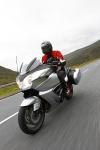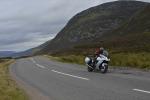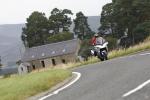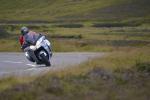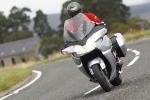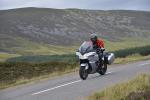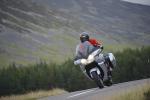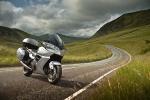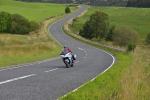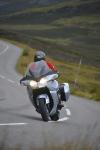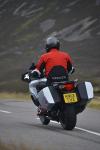Triumph Trophy review
By Kevin Ash - 16/01/2013
Say what you like about Triumph's lack of originality in its engineering and model range, the British factory consistently is churning out some rocking good motorcycles. And the new Trophy is the best Triumph yet.
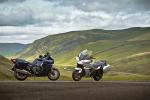
Yes, that's a big thing to say after a line of machines that includes the Daytona 675, Street and Speed Triples and most recently the Tiger Explorer, but the Trophy is not only a complete and astonishingly accomplished machine, it adds a new dimension to what we can expect dynamically of big touring bikes.
The four-cylinder Trophy 1200 was the first model to roll out of the new Hinckley factory 21 years ago, and it was one element of a modular model range inspired by Japanese design and quality standards. The company's progress in all aspects has been phenomenal since then and no model illustrates that better than the latest machine to bear the Trophy name.
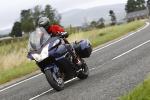
The touring bike class is dominated and defined by BMW's R1200RT, a bike benchmarked by Triumph during the development of the Trophy, and in most of the aspects it's possible to assess in 600 miles (1000km) of riding, the Triumph comes out on top. The most popular version will be the comprehensively equipped SE model as tested, although even the standard version is well specified and serious consideration should be made if paying the SE's £1350 premium is really worth it.
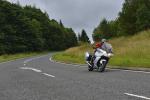
The single most surprising and impressive aspect of the Trophy is its handling. With a quoted wet weight (with a full tank) of 664lb (301kg), 93lb (42kg) more than the RT, you'd expect a slow-turning or even lumbering beast of a bike. It's worth noting however that the BMW figure is without the multitude of extras most examples are fitted with, and it's with a 90 per cent full tank, so the gap is not quite as big as it seems. But regardless of that, the Triumph is agile, fast turning and the best handling touring bike you can buy. It has a very natural feel at low and high speeds and responds eagerly both to bar inputs and also to shifts in your body weight, and so completely belies the given mass figure you begin to suspect that either the rival bike numbers are optimistic or Triumph's is too high.
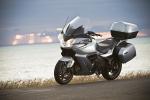
In fact there are several more credible reasons for this unexpectedly enjoyable handling. One of course is Triumph's expertise and experience in this area, shown by all of its recent models handling very well. This comes partly through technical expertise combined with an increasing reliance on its test riders. Product Manager Simon Warburton says: "Despite the big advances in computer modelling and out technical know-how, our test riders put a lot more miles on bikes these days than they did when the first Trophy was produced. There's no substitute for their input."
The design of the bike ranks handling high on its priority list too, with a forward weight distribution of 51.5 per cent pointing at a tactile and secure front end, with decent feedback ensure by the use of conventional telescopic forks rather than the more anaesthetic Telelever design of the BMW.
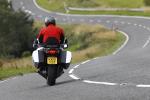
But another factor cited as important by Triumph is the TDLS (Triumph Dynamic Luggage System) pannier mounting system. These allows the panniers to swing freely through a five degree arc while linked to each other, isolating the bike from the resonant turbulence forces which can cause instability on touring bikes. With those isolated from the chassis, the designers were free to give the bike sharper steering geometry, freed from having to ensure it remains stable enough to cope with aerodynamically induced wobbles caused by the panniers. Follow a Trophy at speed and you can often see the panniers shifting side to side: on a bike with rigidly mounted panniers those forces are transmitted to the chassis, which as a result needs conservative geometry to ensure it remains stable.
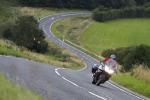
Whether or not the technical side interests you, the result of all this certainly will. On the sinuous, bumpy roads of the Cairngorms region of Scotland the Trophy was an absolute pleasure to fling around. It has that sports bike feel of being an extension of the rider, turning your thoughts into direction changes with little conscious effort, where most touring bikes give the impression you're steering them remotely. It's not a sports bike of course so it doesn't turn as quickly or stop as rapidly, but it's much closer than it has any right to be.
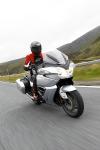
Just one area bothered me, and chatting to other riders as well as Triumph staff I seem to be in a minority over this, but I thought the ride quality could be better. The suspension soaks up small bumps and washboard surfaces very well, but larger bumps, especially sharp ones such as the edges of potholes, can really jar through the bike. Maybe I've been spoiled by the excellence of Triumph's own Tiger Explorer, which performs very well in this respect, but after a long time on board I found the jiggling, restless ride of the Trophy tiring.
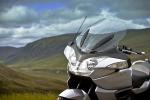
The suspension is certainly set up differently for example to BMW's, using a progressive rear linkage design where the RT's is linear. The idea is to make suspension bottoming out less likely, as in effect it stiffens up more the further it's compressed, but another consequence is that most of the time only 80 per cent of the 5.5in (140mm) wheel movement is generally in use, and sure enough the feel is as if the bike could do with a bit more suspension travel.
The BMW manages with 120mm front travel and 135mm at the rear, but this is linear so it's more fully used up to the point where the suspension hits the bump stops. The RT has a harshness generated by the Telelever transmitting road vibration to the rider, otherwise it seems more plush than the Triumph.
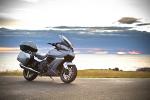
The Trophy SE comes with electronically adjustable suspension (TES, or Triumph Electronic Suspension) with three options of Comfort, Normal and Sport, further adaptable with load bias of luggage or two-up, but this was a little disappointing as the differences between the main settings isn't great. I suspect many riders including myself would struggle to say which had been selected if it wasn't indicated on the dash, although changing from Comfort to Sport does improve stability on twisty roads at speed. Changing the load settings though does help a lot when you're carrying a passenger and luggage compared with leaving them alone - this is the main advantage of the system and worth going for if you do ride with widely varying loads regularly. Most riders though will leave the main setting on Normal then forget about it.
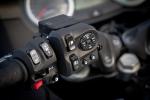
The TES system is less sophisticated than BMW's ESA II. It changes damping and rear spring preload but unlike the German version, not the spring rate, nor does it differentiate between two-up and two-up with luggage, so riders switching from an RT SE - and there will be many - will find they've taken a small step backwards in this respect. But there's very little else about the Trophy where you could say that.
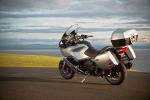
The luggage itself will be familiar to BMW riders as the latching mechanism is the same, although the boxes themselves are made by Triumph. They're very closely integrated into the bike, both visually and physically, they're easy to remove, waterproof, use the bike's ignition key and can be left unlocked so you can open them without having to switch off the ignition each time. They're a good size too at 31 litres each, easily capable of holding a full face helmet each, and they're colour matched, although the painted finish inevitably is vulnerable to scratches and boots.
The Triumph Trophy engine copes with loads of all kinds magnificently. The whole power train is the same as the Tiger Explorer's aside from a longer swingarm and higher ratio top gear, although the peak power is 3bhp less and torque is very slightly down too, due to the different exhaust and intake systems. So you get a 1215cc three-cylinder engine with a désaxé layout - désaxé (technical feature here: the cylinders are offset from the crank centreline by 6mm) - making 132bhp (134PS, 99kW), and most importantly, more than 74lb.ft (10.2kgm, 100Nm) between 2,500 and 9,500rpm.
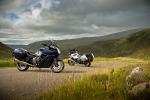
Another important factor from the ownership view is the long service interval, with minor attention required at 10,000 miles (16,000km) and major services at double that. The Triumph Trophy is going to clock up plenty of miles in the hands of many owners so this will become an important advantage in terms of costs as well as time off the road.
The motor feels more sophisticated in the Trophy than the Explorer, partly because vibration is reduced (possibly because of the Trophy's extra mass, but also there's better isolation through the various contact points between rider and bike), and partly because the electronics have been developed further. The throttle action is as light as the Explorer's but the ratio of twistgrip opening to butterfly movement (it's a ride-by-wire system) has been increased to improve control finesse and banish the too-sudden action which can be an issue with the Explorer.
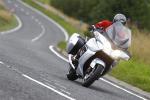
The additional weight of the Triumph Trophy and taller top gear have made little difference to the muscular feel of the motor. It has six gears and feels like it would manage just fine with three, and most importantly you can leave it in top gear and let the bike get on with it, from low speeds where it pulls strongly with a pleasing growl to hustling rapidly along sweeping main roads and overtaking effortlessly.
What's also noticeable is an improvement in fuel consumption compared with the Explorer, which is not bad itself. Maybe this is due to better aerodynamics and perhaps the revised engine mapping has helped, but the weight and bulk seem to have done no harm as the Trophy returned 51mpg (18.1km/l, 5.54l/100km, 42.5mpg US) on my 360 mile (580km) ride from Scotland to England. Pleasingly and usefully, the on-board economy reading was accurate to within 0.1mpg against my fuel pump measurements, although this made the low fuel warning seem even more unnecessarily early.
The ride included all kinds of riding typical to touring so it's representative of what many riders will achieve, but take it easier and you'll see even better, with 55mpg (19.5km/l, 5.14l/100km, 45.8mpg US) easily achievable. High motorway speeds don't hammer the economy either, at a steady 85mph you'll see up to 48mpg (17.0km/l, 5.88l/100km, 40.0mpg US), which given the 5.7 gallon (26 litre, 6.9 gallon US) tank capacity means the bike has a genuine 300 mile capability.

That ability extends to comfort, as you'd hope. The seat doesn't feel especially plush at first but it has a large area of support and remains comfortable after many hours on board, which is what matters. The riding position is quite upright but not to the point where it induces back ache, while the leg room is adjustable by way of altering the seat height. In Europe this varies between 800mm and 820mm (adjustable in 30 seconds including removing and replacing the seat), while the US gets a 760-780mm seat as standard and the European one as an option (the lower seat is an option in Europe).
The screen is outstanding, with enough travel to suit taller riders such as myself in its highest position. It's electrically adjustable via a button on the left handlebar, and when the ignition switches off it parks in the low position - a sensor detects if there's an obstruction. Switch on again and it returns to where it was previously set. At speed, as it reaches its most upright setting the quiet is almost uncanny, you really don't need earplugs and the audio system is very easy to hear. The wind shadow extends right around the rider with very little turbulence intruding and in the wet, very little water either. In one downpour only my boots became wet, and even then it took some time for that to happen. The Trophy's rider protection from weather and slipstream are the new benchmark for touring bikes, it's that good.
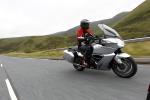
The story's the same for the passenger, who gets an exceptional amount of room along the length of the bike, with big, easy-to-use grab handles (although the more generously proportioned might find they're sitting on their thumbs). The wind protection on the back is just as good as the rider's, and on the SE the pillion gets an additional 12v socket and the option of a heated seat. The panniers don't intrude too much into the leg space either. Heat management is very good, for rider and passenger, with neither being exposed to engine heat around the legs or in the backside. In all, the back of a Trophy is a good place to be.
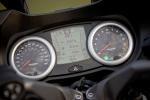
There's plenty to do in the cockpit when the scenery's not interesting. The Trophy has the most comprehensive dash yet seen on a motorcycle, and fortunately it's more intuitive than earlier Triumph efforts, although you'll need to spend some time learning and familiarising to get the most from it. The audio system includes ambient noise compensation with automatic volume and equalisation adjustment, and has a FM/MW/LW RDS radio and MP3 compatibility. There are dual Bluetooth chips so rider and passenger can connect headphones. On the SE you get a USB connection too, and the system reads a wide format of sound files from that. The speakers sit in enclosures designed to enhance the sound, but its quality isn't especially good. It's clear enough but could do with a richer tone and stronger bass. Then again, most speakers don't need to be waterproof. Annoyingly though the fat antenna flaps about wildly at higher speeds as the turbulence around the edge of the screen hits its resonant frequency. A hidden aerial would avoid this and look less old fashioned too.
The system is fully integrated with the main display screen, including operation of your iPod, and there's plenty more on there to keep you busy. Information includes all the basics of course plus instant and average economy, fuel used, ambient temperature, range, trip mileage, time of trip, tyre pressures (a cost option on the base model as well as the SE), all configurable in a multitude of ways. You can specify which items are permanently displayed and which appear as you scroll through, the units they're displayed in and very usefully can have the speed appearing digitally in different units to the main analogue speedometer. A typical Trophy refinement is that one trip can be made to reset automatically after varying times of ignition off, so it's always zeroed when you start a fresh day, and there are many other personalisation possibilities. Very usefully, the headlight angle is adjustable via the dash, important on a bike which will have a wide range of loads.
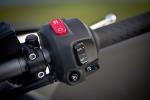
The sophistication extends to the braking system, which has a very effective ABS and also front to rear linking. The handlebar lever operates four pistons in one front calliper and two in the other, while the rear pedal operates the rear alone when used gently, then the front with variable balance as it's pressed harder. The result is completely unintrusive, well balanced braking with enough feedback to enhance the tactile chassis.
There are plenty of pleasing details on the Trophy, such as the rubber edging trim on the mirrors to protect against scrapes against walls and so on when parking the bike, and a waterproof storage space in the fairing which locks automatically when you leave the bike or above 5mph. Inside is a credit card holder which is easy to use even with gloves, although the tough plastic film on our test bikes protecting the area of the tank where legs rub is an accessory fitment which really ought to be standard.
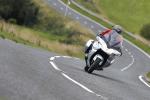
The cruise control is the same system as on the Tiger Explorer but it's been updated and refined (and as with the throttle mapping this will be downloaded to existing Explorers from late in 2012). On the Explorer it's currently unsatisfactory, hunting too much around the set speed, but on the Trophy it works perfectly, holding a speed consistently even on undulating terrain and returning to a set speed more positively.
There's a huge amount to say about the Triumph Trophy, but it's the very basics which make it such an impressive machine. The ride quality is a little disappointing but as this is by some margin the best handling bike in the class many will forgive it that, especially when you take into account its incongruous agility, while many testers didn't seem to notice anyway. It offers the best protection from the weather and slipstream, with a huge 300 mile range and comfort that's well up to that kind of distance. The engine is masterful, with a massive spread of torque and a perfect balance of smooth sophistication and snarling three-cylinder character - the impressive economy is a surprise bonus too. It's also beautifully put together, with high quality paint and corrosion-resistant finishes on all the exposed fittings and fixtures, and with BMW still struggling to get its act together regarding reliability, Triumph's dependability adds further appeal.

Then there's the price. The basic Trophy is £12,949 and the SE £14,299, and the main comparison must be with the BMW R1200RT (although a comparison with Honda's dated £14,000 Pan European are equally valid). The basic 1200RT costs £12,695 but is poorly specced compared with the entry Triumph, which comes with cruise control, tyre pressure monitoring, two 12v sockets, traction control, on-board computer and electric headlight adjustment as standard. Add those to the RT (and most buyers will want them) and its price rises to £13,785, and that's without electric headlight adjustment as it's not available.
Take the RT up to Trophy SE spec and you're up at around £16,000, although the RT's sound system is very costly at £1,050 plus £360 for the wiring. But however you look at it, the Triumph offers better value even if the bikes were otherwise indistinguishable. Add its dynamic and ergonomic superiority, low servicing needs and what looks likely to be better reliability, and its claim to be the new king touring bike looks utterly compelling.
Model tested: Triumph Trophy SE
UK price: £14,299
Available: end October 2012
Engine: three cylinder, liquid cooled, dohc 12v, 1215cc
Power: 132bhp (134PS, 99kW) @ 9,000rpm
Torque: 89lb.ft (12.2kgm, 120Nm) @ 6,450rpm
Economy:51mpg (18.1km/l, 5.54l/100km, 42.5mpg US)
Tank/Range: 5.7 gallon (26 litre, 6.9 gallon US) / 290 miles (470km)
Transmission: Six gears, shaft final drive
Chassis: tubular aluminium
Seat height: 31.5/32.3in (800/820mm) US: 29.9/30.7in (760/780mm)
Wheelbase: 60.7in (1542mm)
Rake/trail: 27 °/4.69in (119mm)
Claimed weight: 664lb (301kg) wet, full tank
Measured weight: n/a
Donate to the Kevin Ash Fund
Kevin's funeral was held on Thursday 28th February 2013 and was well attended by family, friends and colleagues.
The Telegraph has very kindly established The Telegraph Kevin Ash Fund to assist with the education of Kevin's three daughters.
If you'd like to make a donation then you can use the PayPal 'Donate' button below which will allow you to donate from your PayPal account, or via credit or debit card. A small percentage (about 3.4%) will be retained by PayPal for the service.
Kevin's family have been touched by the generosity and messages of support from people using the website and would like to express their gratitude to those who have contributed in any way.
The donations keep coming in, thank you so much, and the family especially like it when you leave a message.
Home | ![]() facebook.com/KevinAshFund
|
facebook.com/KevinAshFund
| ![]() twitter.com/KevinAshFund | © 2013
twitter.com/KevinAshFund | © 2013
